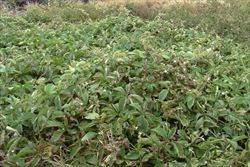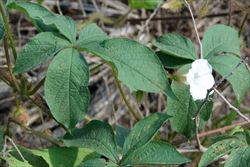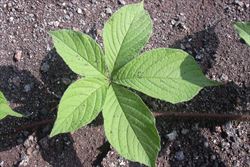Click on images to enlarge

infestation (Photo: Forest and Kim Starr, USGS)

hairy leaves, stems and flower sepals (Photo: Forest and Kim Starr, USGS)

close-up of leaf with five leaflets (Photo: Forest and Kim Starr, USGS)

close-up of flower (Photo: Forest and Kim Starr, USGS)

close-up of very hairy mature fruit (Photo: Forest and Kim Starr, USGS)

seeds (Photo: Forest and Kim Starr, USGS)

young plant (Photo: Forest and Kim Starr, USGS)
Scientific Name
Merremia aegyptia (L.) Urb.
Synonyms
Ipomoea aegyptia L.
Family
Convolvulaceae
Common Names
hairy merremia, hairy morning glory, hairy morning-glory, hairy woodrose
Origin
A widespread species in the tropical regions of the world (i.e. pan-tropical). Its exact origin is obscure.
Naturalised Distribution
Naturalised in some parts of northern Australia (i.e. the coastal districts of northern Western Australia and the northern parts of the Northern Territory).
Notes
Hairy woodrose (Merremia aegyptia) is regarded as an environmental weed in the Northern Territory and northern Western Australia. It is also listed as a priority environmental weed in at least one Natural Resource Management region in northern Australia. This fast growing twining vine has escaped from gardens and covers native plants, trees and fence lines in disturbed sites and riparian areas.
Hairy woodrose (Merremia aegyptia) has taken over large areas of disturbed land in northern Western Australia, particularly around Broome and Kununurra. It has also been reported from vine-forest margins near Darwin in the Northern Territory and recorded from conservation areas in this region (e.g. Holmes Jungle Nature Park). This species is also listed as a medium priority weed in aboriginal lands in the Northern Land Council area.

